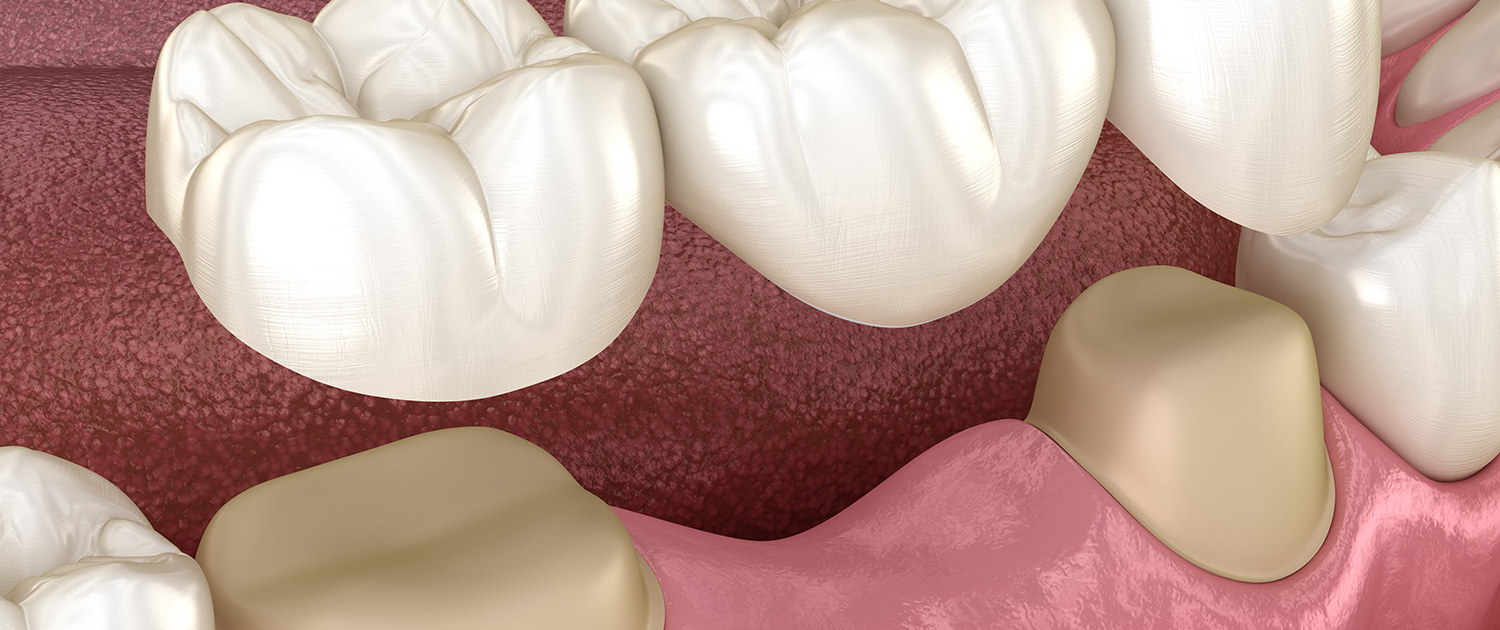Dental crown, tooth bridge, removable and fixed prosthesis
What is a tooth prosthesis?
Prosthetics is the field of dentistry, which replaces the missing teeth with various fixed or mobile restorations, that comes to answer the functional and aesthetic problems that arise when teeth are missing, restoring in the best possible way, the normal function, and the healthy and aesthetically pleasing appearance of the patient.
Prosthetic restorations are divided into two categories, depending on whether they remain firmly attached to the patient’s mouth on a permanent basis, or can be easily removed by the patient.
Tooth case or dental crown
A dental crown, or case as it is otherwise called, is a cover made of either entirely porcelain or a metal frame inside and porcelain outside. It covers the entire tooth (after previously removing some enamel and dentin) and protects it from any fractures. With the crown we can change the colour and the shape and size of the tooth with great success.
A dental crown can be placed in the following situations:
- In teeth that had undergone root canal treatment.
- In broken teeth when their restoration is not possible by other means.
- On teeth with large fillings.
- In case there is a loss of tooth surface due to age or as a result of habits such as tooth grinding (bruxism).
- To improve the aesthetic appearance of a tooth (if we want to change the colour, shape, layout of the front teeth and there is no possibility of applying a more conservative technique such as veneers, bleaching, etc.).
- To support a removable denture or bridge when adjacent teeth are missing.
In these cases, the preparation and placement of a personalized crown is considered the only solution, in order to keep the tooth without the risk of fracture.
Dental bridge
Bridges are structures that replace one or more missing teeth. The adjacent teeth are prepared properly, dental tissues (enamel and dentin) are removed, and crowns are placing on them, “bridging” the gap that existed.
The dental bridge is permanently cemented in place on the dental abutments – that is, the end teeth that define the space. Unlike removable partial dentures, the fixed dental bridge cannot be removed by the patient. A fixed dental bridge is a device that typically consists of 3 elements: an artificial tooth (called pontic) joined between two crowns which are attached to the dental abutments.
In which cases is a dental bridge used?
If you are missing any teeth and you have good oral hygiene, then you are an ideal candidate for a bridge. The dental bridge is the most natural option to fill the gap created in the mouth caused by the missing teeth.
Fixed bridges improve chewing and speech while protecting your appearance by preventing the breakdown of facial features, which can cause premature wrinkles and aging.
Prerequisites for the safe preparation of a dental bridge
- The number of missing teeth should not be large. In general, we would say that a bridge should not replace more than three consecutive missing teeth.
- The natural adjacent teeth that will support the bridge should be healthy.
- There should be natural teeth on either side of the gap, so that the bridge has support at both ends.
- There is no periodontal disease, or it has been brought under control after proper treatment.
- The person to whom the bridge will be placed has to have a good oral hygiene.
Metal-ceramic bridges
A porcelain bridge that has an inner metal layer (metal-ceramic) is arguably the best choice for the back of the mouth. Bridges of this type generally have good aesthetics, high durability, and a wide range of applications.
Ceramicbridges
All-ceramic bridges are a system that allows a porcelain crown to be constructed without a metal frame. All-ceramic tooth bridges are aesthetically pleasing, they look exactly like natural teeth and at the same time they are very safe and unbreakable.
Zirconium bridges
Zirconium is the white inner core of the bridge which is very strong. It makes the bridge colourful and the teeth almost the same as the natural ones. It is the ultimate choice if you want an unquestionably aesthetic result.
Zirconium is so hard that it can only be cut with a laser and increases the naturalness of the bridge due to its colour.
All-ceramic zirconium bridges are works of art that can withstand high pressures and can be used for a large rear bridge in the chewing area.
Removable dentures
The removable prosthesis includes the design and application of structures that replace the lost teeth, in whole or in part, with artificial teeth and that the patient can remove whenever he / she wants. These constructions are:
- Complete / total dentures
Complete dentures are removable prosthetic structures that replace the entire set of teeth. That is, they are used if there are no teeth in the patient’s mouth and no fixed prosthetic restoration can be done on implants. However, in some cases 2 or 4 implants can be placed under the entire denture making it really almost immobile using precision connectors.
- Partial dentures
They are removable prosthetic structures that usually make up for the loss of several teeth and adjacent soft tissues. They consist of 2 parts, a pink or gum-coloured plastic base and the replacement teeth made from materials such as acrylic, nylon etc. This construction has built-in special hooks. These “fasten” on properly prepared natural teeth, thus giving a satisfactory support to the partial denture.
It is important that removable prostheses, both partial and total, are removed daily from the patient and thoroughly cleaned.

